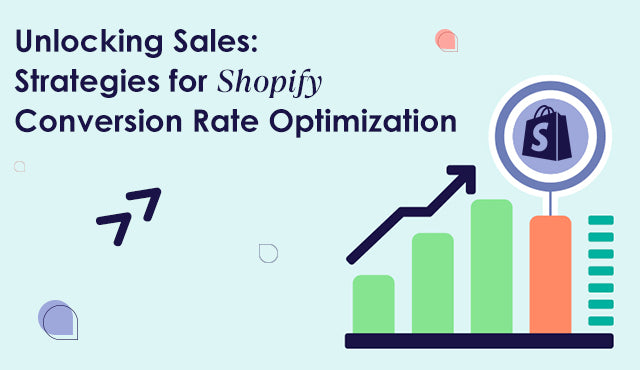In the competitive world of e-commerce, attracting customers to your Shopify store is only half of the challenge. The real challenge is converting those visitors into paying clients. Here's where Shopify Conversion Rate Optimization (CRO) comes into picture. In this comprehensive instruction, we'll go over the fundamentals of Shopify CRO, discuss its importance and present actionable techniques for increasing your store's conversion rates.
Understanding Shopify Conversion Rate Optimization (CRO)Shopify Conversion Rate Optimization (CRO) is the process of improving your Shopify store's performance to encourage more visitors to take desired actions, such as making a purchase, signing up for a subscription, or adding things to their cart. Essentially, CRO aims to maximize the percentage of website users that fulfill a specified goal, resulting in increased revenue and profitability.
Why Shopify CRO Matters:Investing in Shopify CRO is crucial for several reasons:
1. Increased Revenue: Improving conversion rates allows you to create more sales without increasing your marketing expense.
2. Enhanced User Experience: CRO entails optimizing numerous areas of your website, resulting in a more efficient and intuitive user experience for visitors.
3. Competitive Advantage: In a congested e-commerce landscape, organizations who prioritize CRO gain a competitive advantage by collecting more conversions from current traffic.
4. Data-Driven Insights: When implementing CRO techniques, data and metrics are analyzed to better understand customer behavior, which can then be used to influence future marketing and product decisions.
Getting Started with Shopify CRO:1. Define your goals: Identify specific activities you want visitors to perform on your Shopify store, such as completing a purchase, subscribing to a newsletter or getting a quote.
2. Conduct web audits: Review the existing website's design, user interface, navigation, checkout processes and product pages to identify areas for improvement.
3. Utilize A/B Testing: Experiment with different areas of your website, such as headlines, call-to-action buttons, photos, and product descriptions to see what works best for your target demographic.
4. Optimize for mobile: With an increasing number of consumers browsing and shopping on mobile devices, make sure your Shopify store is ready for seamless mobile experiences.
5. Improve Site Speed: Slow-loading websites can discourage visitors and decrease conversion rates. Optimize your site's speed by compressing pictures, limiting HTTP queries, and exploiting browser caching.
6. Streamline the Checkout Process: Reduce the amount of steps required to complete a purchase, provide guest checkout options, and use trusted payment channels.
7. Implement Trust Signals: Showcase trust badges, client testimonials, security certificates and guarantees to reassure your audience about purchasing from your store.
8. Personalize the User Experience: Use consumer data and behavior to provide personalized product recommendations, customised marketing and targeted offers that increase relevance and engagement.
9. Monitor and analyze performance: Regularly monitor key metrics like conversion rate, bounce rate, average order value and cart abandonment rate to track the performance of your CRO efforts and identify areas for further optimization
Plotting the Course: The Importance of SEO, SMO, and PPC:As we navigate the tumultuous waters of e-commerce, we must rely on strong allies such as Search Engine Optimization (SEO), Social Media Optimization (SMO), and Pay-Per-Click (PPC) advertising. These digital navigational tools act as the wind in our sails, propelling our Shopify store ahead and expanding our reach over the broad digital landscape.
- 1. SEO: Charting the Waters of Discovery: SEO serves as our cartographer, mapping out the digital terrain and ensuring that our Shopify store is readily discovered in the enormous ocean of search engine results. By optimizing keywords, meta tags, and website content, we lay the groundwork for long-term visibility and organic growth.
- 2. SMO: Hoisting the Colors of Engagement: SMO stretches our social sails, leveraging the power of social media platforms to magnify our message and engage our audience. We generate a dedicated following that champions our brand across the digital seas through smart content creation, community building, and influencer collaborations.
- 3. PPC: Setting the Course for Targeted Acquisition: PPC serves as our navigator, steering our ship toward targeted acquisition and strategic conquests. We navigate the hazardous seas of paid advertising by carefully crafting ad campaigns, keyword targeting, and audience segmentation, maximizing ROI and acquiring valuable leads along the way.
As we navigate the waves of e-commerce, it's critical to have a thorough armory of Shopify Conversion Rate Optimization (CRO) tactics. From improving website design and expediting the checkout process to using tailored suggestions and trust signals, each technique acts as a navigational light, directing visitors to conversion and propelling our Shopify store to new heights.
Conclusion:Shopify Conversion Rate Optimization (CRO) is crucial for e-commerce success. It maximizes website traffic value and drives long-term growth. By applying the tactics mentioned in this article and constantly improving your strategy based on data and insights, you can maximize the potential of your Shopify business and achieve long-term success in a competitive online economy.


